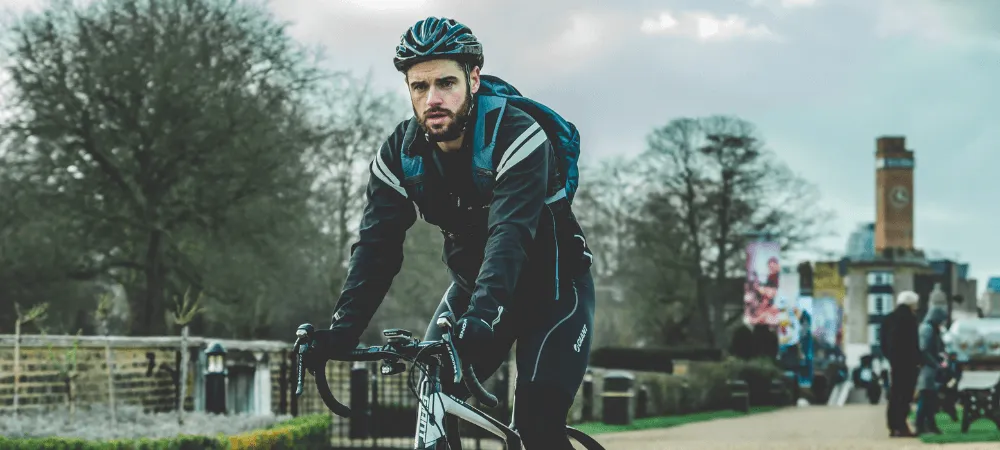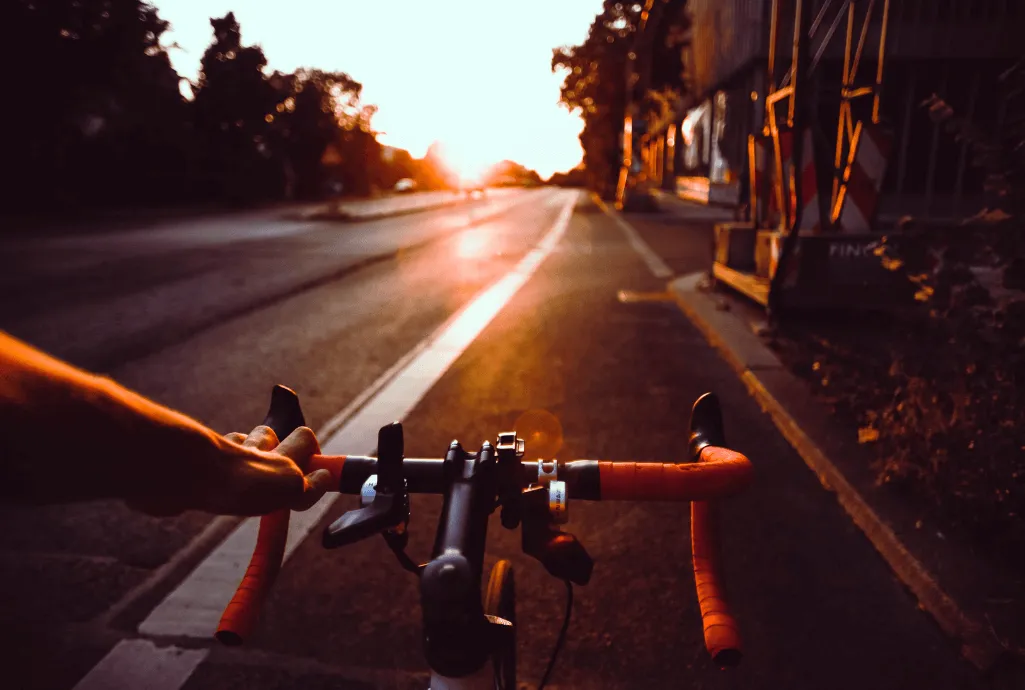Cycling for beginners can be very intimidating. Here are 10 things every beginner cyclist should know.
When I started my cycling journey I made several mistakes that slowed my progress. Based on my personal experience, I selected the 10 most important aspects.
The goal of this article is to answer the most frequently asked questions. These answers will provide you with important knowledge that will speed up your development as a cyclist.
Here are my recommendations for bicycling beginners:
#1 – Choose the bike type
#2 – Determine the correct bike size
#3 – Learn using gears
#4 – Get geared up
#5 – Create a habit
#6 – What to eat and drink during a cycling session?
#7 – Prevent overtraining and schedule rest days
#8 – Stay safe on the road
#9 – Join a cycling club
#10 – Bicycle maintenance basics
Closing thoughts
#1 – Choose the bike type
Choosing a bike type is the first step for a beginner in the bicycling world. Each bike type has its pros and cons and favors specific needs. For example, road bikes are designed for higher-speed riding on paved terrain. While mountain bikes are built for off-road cycling.
In case you don’t know much about bike types then I have a whole article dedicated to this topic. It provides necessary knowledge, so you can determine the right type.
#2 – Determine the correct bike size
Determining the correct bike size is the most important aspect when buying a bike. Correct bike fitment will ensure you won’t experience any discomfort while riding and you will be able to use your leg power properly.
There are hundreds of bike brands available on the market and their bikes are all different in size. One brand’s 18″ frame size can be another brand’s 15″. You might ask why, but there is no real explanation for that.
You can determine the correct bike size in two ways. The first approach determines the best bike frame for you according to your height. It is quite a generic approach and it’s far from being ideal.
Bike size based on a height chart
| Height (in & ft) | Height (cm) | Frame Size (in) | Frame Size (cm) |
| 4’12” to 5′ 3″ | 150 – 160cm | 13 to 15 inches | 33cm – 38cm |
| 5’3″ to 5′ 7″ | 160 – 170cm | 15 to 16 inches | 38cm – 40cm |
| 5’7″ to 5′ 11″ | 170 – 180cm | 16 to 17 inches | 40cm – 43cm |
| 6’0″ to 6′ 2″ | 180 – 188cm | 17 to 19 inches | 43cm – 48cm |
| 6’2″ to 6′ 4″ | 188 – 193 cm | 19 to 21 inches | 48cm – 53cm |
| 6’4″ and taller | 193cm and taller | 21 inches and up | 53cm and up |
Bike size based on inseam Length chart
The second approach is based on measuring your inseam and calculating the correct frame size. This method is more accurate as it takes into consideration your leg length. I am sure you have some friends who are shorter than you, but when you sit behind the table then your height is about the same.
Here is the formula:
Road bike: x 0.70
Mountain bike: x 0.685
City bike: x 0.685
Bike Type x Leg inseam = Your frame size (in centimeters)
If you’re interested in learning more about bike frame size charts, then I have an article about this topic. In this article, I wrote about 12 different bike frame size charts and answered frequently asked questions.
#3 – Learn using gears
Gears are like your personal assistants when there is a steep hill coming or you want to reach the highest speed possible. They allow you to pedal in comfort despite terrain characteristics.
Different bike types have different numbers of gears. For example, my bike has 27 gears. Usually, front gears can be changed by the left-hand shifter and rear gears with your right hand. As a rule of thumb rear gears are easier to pedal, but give you more torque and boost cadence while front gears are harder, but give you more speed.
I learned to use my gears thanks to the cycle computer. This little computer is connected to a bike transmitter that reads the pedaling rate. Thanks to this approach, I learned what my average cadence is and since then I adjust my gears accordingly. When my cadence is too high, I increase the gear and vice versa.
Cadence can be also calculated without any modern electronics. When you cycle at comfortable (preferably stable terrain), count for 10 seconds and multiply the number you got by 6. This little trick will help to determine your cadence.
With time you will learn to feel whether you’re at your perfect cadence and shift accordingly.
Want to read more about this topic? I have a separate article about gears, shifting techniques, cranksets and cassettes.

#4 – Get geared up
Receiving your new bike is always very exciting. But before you go on your first ride, you have to think about some equipment.
I will be honest here with you, you don’t need any fancy or flashy stuff as a beginner. Most important besides the right bike and correct size is your helmet.
Bike riding is relatively safe, but sometimes things happen and protecting your head is most important. A good helmet will save you from a concussion or worse.
If you plan to ride when it’s dark outside, I recommend you buy front and rear reflectors. They will make you visible to the cars.
Another thing that I find important is some sort of a tracker. I’d go for some smartwatch that is capable of tracking heart rate and distance traveled on a bike. Such data is a great asset when it comes down to drawing conclusions or analyzing your progress over time.
As your training sessions will get longer, you might want to purchase a saddle bag and a water bottle.
#5 – Create a habit
Depending on your fitness level, most likely your first rides will be tough. Your muscles will be sore the next day and your overall energy low. This will last for some time until your body learns how to deal with and adapt to such stress.
As soon as your body adapts, the soreness will be no problem after every ride and cycling will start to make you a happier person. There are dozens of health benefits and many cyclists feel happier and accomplished after each session.
My recommendation is to start slow and set personal goals in terms of training hours or miles traveled.
#6 – What to eat and drink during a cycling session?
Firstly, let’s talk about when you should drink and eat. It depends on several factors and also whether you had something to eat before your session.
If my session exceeds 60 minutes, then I carry with me a water bottle. If my session is longer than 90 minutes then I grab a few snacks. Cyclists usually carry energy gels, sweet gummies or calorie-rich bars.
Another factor is of course where you live and how many hills you have around. Heat is a big external factor that puts on your body additional stress. I avoid cycling when it’s the hottest time of the day. All my sessions happen either early in the morning or before sunset.
#7 – Prevent overtraining and schedule rest days
Cycling is considered a low-impact sport and it doesn’t overload your joints or knees. But, going too hard without prior fitness preparation can harm your well-being and make you exhausted, nervous and drained.
I recommend developing a structured plan where you set your training and rest days. At the beginning of my cycling journey, I had a training session every third day. In other words, I had 2 days off after a single 60min training session.
#8 – Stay safe on the road
Depends where you will have your cycling sessions, but most cities don’t have countless bike lanes. As a result, cyclists start using roads or motorways.
If you have a driving license then this is a very big advantage when it comes down to cycling on the roads and motorways. Due to prior driving experience, your confidence and awareness are well developed.
In case you don’t have a driving license, then you have to learn some basics and get street-wise. Here are a few recommendations from my side:
- Stay always rightmost lane
Plan your turns. If you need to turn left, do it from the left lane. - Show your turns with your hands. For example, if you want to turn right, extend your right arm straight.
Another recommendation for all beginners is to use the same roads as long as possible. With time you will become more familiar with the streets and your confidence grows.
If you plan to cycle alone then always carry with you an identification document. Also always let someone know where you go and when you plan to come back. A lot of cyclists share their location with family members or friends.

#9 – Join a cycling club
Many think that cycling is purely a solo sport, but it’s not. There are lots of clubs and smaller independent groups that cycle together.
Group cycling is more fun and it gives you extra motivation going through another training session. People there are generally very friendly, motivating each other and everyone is welcome.
I have a list of clubs all over the United States and Europe. In case you are interested, take a look at this list and find the closest club to where you live.
#10 – Bicycle maintenance basics
You don’t need to be tech-savvy and understand how to do bicycle maintenance basics. The best part of maintaining your bike is that there are no special tools needed. Hew are a few recommendations:
Check your tire pressure on a weekly basis
Check your tire pressure on a weekly basis. The higher pressure tires you have, the quicker the pressure will drop with time or miles ridden. Check recommended pressure on the sidewall of bike tires.
Chain lubrication
I recommend buying bike chain lubrication. Lubricating your chain will extend the chain lifespan. If the chain gets dirty due to rainy weather or muddy landscape then friction will increase and as a result chain components will wear off quicker.
Keep your bike clean
I wash my bike with car shampoo. Most car shampoos are pH neutral, so they won’t affect paint. I recommend you not to let dirt accumulate as it will be harder in the future to wash it off.
Wonder what to do if your chain drops or how to puncture a tire? Read my 101 maintenance guide.
Closing thoughts
Riding a bike is fun and it makes people happier. Don’t overthink too much about what bike type to buy or how to use your gears. Enjoy the process and celebrate your personal development.
In case you worry about where and how to store your bike, read our article about apartment bike storage solutions.

